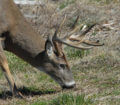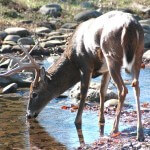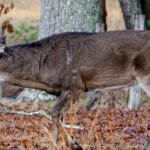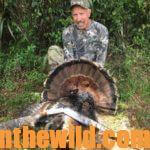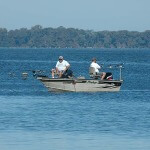Editor’s Note: If you saw your cousin, your brother, your sister, your uncle and your aunt get run over by an 18-wheeler every time one of them tried to cross a six-lane interstate, then you probably wouldn’t attempt to cross that interstate yourself. Just like you’d learn not to play in traffic from observing what happened to your family on the interstate, older bucks with large racks and heavy body weights learned at an early age that if they went into a green field during hunting season in the daytime, more than likely they never would leave the green field. But most hunters plant green fields to grow bigger bucks and think they’ll bag them at the green fields. Here’s the reality –the mature bucks will become nocturnal first. Because younger bucks haven’t learned the danger that awaits them in the green fields, hunters who sit in shooting houses over green fields have noticed they generally take smaller, younger bucks than hunters do in stands 50- to 200-yards away from those green fields. Now scientific evidence proves the truth of this assumption.
 Although outdoorsmen have become very-effective deer managers in recent years, Dr. Grant Woods, a wildlife researcher and biologist, believes many hunters’ skills have declined. “In the last couple of years, I’ve found that helping my clients grow mature bucks is much easier than having one of my clients harvest a mature buck.”
Although outdoorsmen have become very-effective deer managers in recent years, Dr. Grant Woods, a wildlife researcher and biologist, believes many hunters’ skills have declined. “In the last couple of years, I’ve found that helping my clients grow mature bucks is much easier than having one of my clients harvest a mature buck.”
In years past, Woods had to struggle to grow mature bucks, since most of his clients harvested 1-1/2- to 2-1/2-year-old bucks and never harvested any does. Even several years ago, few landowners or hunting clubs conducted much deer management on a large scale. But today, with the large volumes of information available about how to manage deer and how to grow big deer, most hunters have learned what’s required to grow big bucks. But very-few hunters today have the skills required to harvest these older-age-class bucks.
Dr. Woods explains, “We’re seeing more and more bucks moving into the 2-1/2-, 3-1/2- and 4-1/2-year-old-age classes. But now that we’re raising these deer, some folks have quit being hunters and have become observers, rather than predators.”
 Do you remember when we all got up early, went to the woods, scouted hard, set up with our binoculars, watched for deer to determine where they came from and went to and tried to set up a game plan for taking those deer? We noted the wind and the weather conditions, reduced the amount of noise we made going to and from our stands and used our hunting skills and what we knew about the hunting environment to hunt those whitetails. Today, many of us hunt by jumping on our 4-wheelers, driving to our condo stands or climbing up in our shooting houses, turning on our headset radios to listen to football games and then waiting on big bucks to appear.
Do you remember when we all got up early, went to the woods, scouted hard, set up with our binoculars, watched for deer to determine where they came from and went to and tried to set up a game plan for taking those deer? We noted the wind and the weather conditions, reduced the amount of noise we made going to and from our stands and used our hunting skills and what we knew about the hunting environment to hunt those whitetails. Today, many of us hunt by jumping on our 4-wheelers, driving to our condo stands or climbing up in our shooting houses, turning on our headset radios to listen to football games and then waiting on big bucks to appear.
“Predators don’t use permanent fixtures like condo stands,” Woods reminds us. “Now, I’m not advising that we completely abandon hunting from condo stands, but I am suggesting that this shouldn’t be our only method of hunting.”
The two biggest bucks Woods ever took came from regions that no one ever had hunted. According to Woods, “To take a big buck, you’ve got to surprise that buck. You’ve got to be in a place where he doesn’t expect to see you, at a time when he’s not looking for you, in an area where other hunters aren’t hunting. A buck makes his living every day by being a survivalist.”
Hunters often hunt over green fields, scrapes or in places where everyone expects bucks to appear. However, when deer come to those areas during the daytime, they’re keyed-up and looking for predators. They’re testing the wind, searching for movement, listening for unnatural sounds and keenly aware of their environment. But if you take a stand where a deer doesn’t expect to see you, he’s not nearly as alert, and you’ll have better odds of bagging him. Research shows that if you prefer to take a big buck, hunt away from the green fields. If you want to take a little buck, continue to hunt over the green fields.
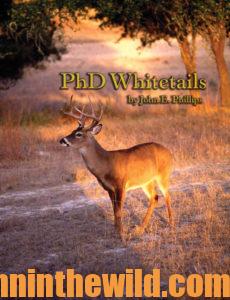 To learn more hunting deer, check out John E. Phillips’ book, “PhD Whitetails: How to Hunt and Take the Smartest Deer on Any Property,” at https://www.amazon.com/dp/B007A2N792 that’s available on Kindle.
To learn more hunting deer, check out John E. Phillips’ book, “PhD Whitetails: How to Hunt and Take the Smartest Deer on Any Property,” at https://www.amazon.com/dp/B007A2N792 that’s available on Kindle.


